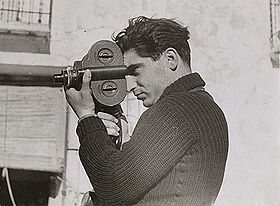
“American soldier landing on Omaha Beach,
D-Day, June 1944.”
Photo taken by Robert Capa. June 6th 1944.
Of the 106 photos that Robert Capa took on June 6th, 1944, only 11 of them survived. Of those 11, there is one that stands out above the others as “American soldier landing on Omaha Beach, D-Day, June 1944.” This picture depicted a soldier making his way through the surf to the dry land of Omaha Beach in Normandy, France. This iconic picture launched Capa’s already thriving career into new heights, as it depicted an American soldier on D Day (no other photographer got this picture).
Furthermore, there was much hubbub surrounding the picture. Not just because of its rarity, but because of the soldier in the picture. For many years, no one knew exactly who the soldier was. It had been debated for years that the soldier could be one of two men fighting on the beaches of Normandy that morning. At first, the soldier was identified as Edward Regan of the 116th Infantry Regiment’s 3rd Battalion of Company K. However, it was later discovered that Regan had landed on Utah Beach, not Omaha. This left only one other option. A historian by the name of Lowell Getz did some research into who this man, and his findings show that the soldier is actually Huston Riley.
PFC Huston Riley of the 16th Regiment’s 2nd Battalion of Company F landed on Omaha Beach with other Allied Forces on the morning of June 6th, 1944. As Riley retells he story, he states, “I was surprised to see him there. I saw the press badge and I thought, ‘What the hell is he doing here?’” He went on to say, “He [Capa] helped me out of the water and then he took off down the beach for some more photos.” Riley was one of only 9 men in his company to survive the invasion.




